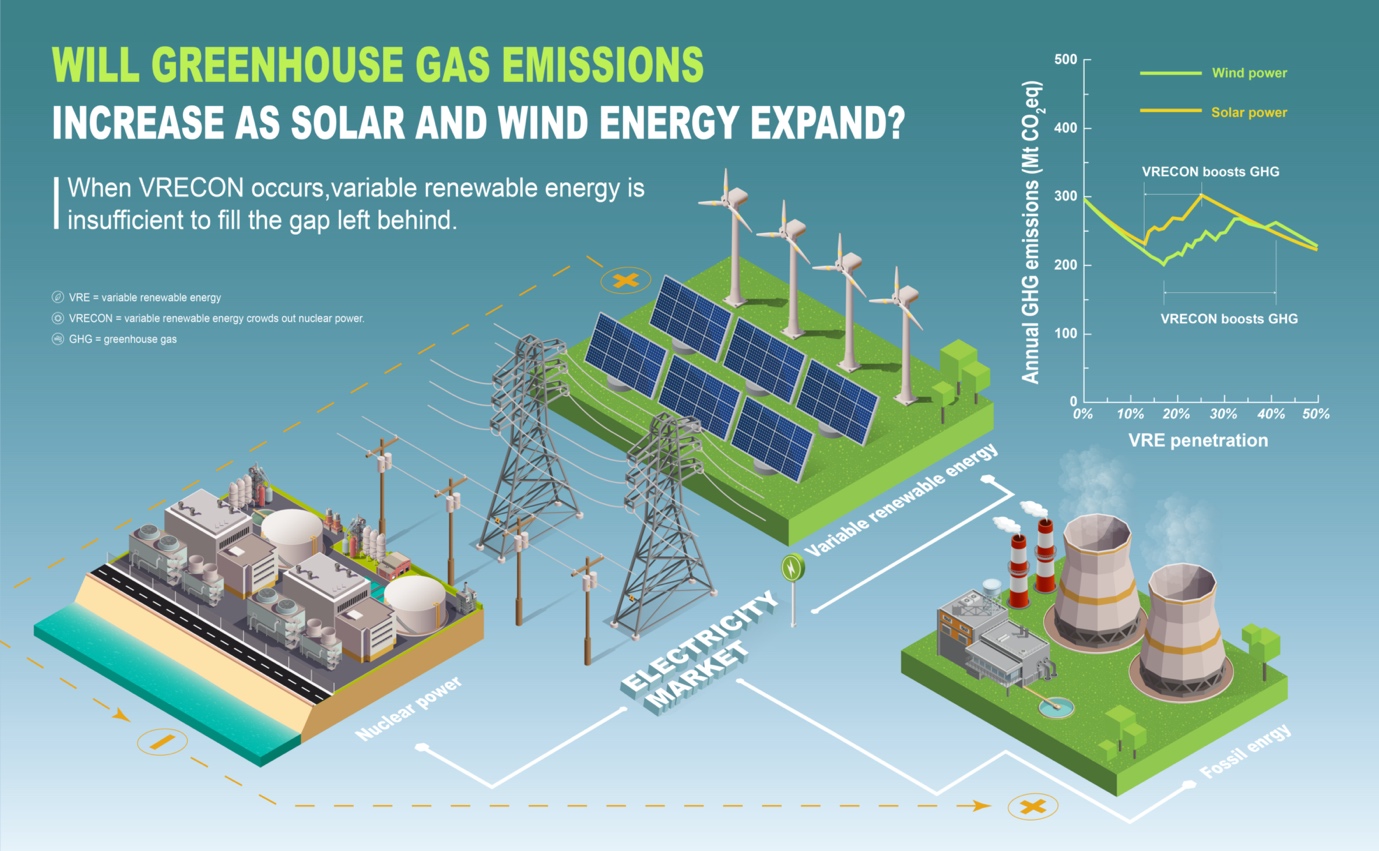Modelling suggests that the growing use of fluctuating renewable energies may temporarily handicap nuclear power and increase fossil fuel use.
Renewable energies, such as wind and solar power, are increasingly used all over the world. New research from Tsinghua University suggests that these energies can make it hard for nuclear power to remain competitive – but because solar and wind power both fluctuate, this leaves an opening for the use of fossil fuels as a supplement.

In modelling one United States electricity market, when wind energy reached 17% of the market, or solar energy reached 13%, they triggered nuclear retirement and increased fossil-fuel use, resulting in higher greenhouse gas emissions.
Temporarily, this could actually lead to an increase in the greenhouse gas emissions, says Yang Yu from Tsinghua’s Institute for Interdisciplinary Information Sciences in Beijing.
“Solar and wind energies are affected by the weather, so they usually only produce electricity during specific periods. For example, solar power only generates electricity during the day,” he explains. These ‘variable renewable energies’ cannot fully service that market, says Yu.
But as they grow in use, variable renewable energies can make it hard for nuclear power to achieve economies of scale. As a result, it’s likely that as solar and wind energy use grows, the electricity market will favor cheaper high-greenhouse gas emitting coal- and gas-fired energy to meet excess electricity needs when variable renewable energy is scarce.
Currently, nuclear power accounts for 10.1% of global electricity generation. But if a tipping point is reached and existing nuclear energy sources are shut down, greenhouse gas emissions could go up, says Yu (see graphic).
Progressive markets – early insights
Yu’s research team explored this idea in an analysis published in February 20221 that modelled two real electricity markets, predicting how much electricity would be dispatched hourly, as well as energy generator investment and retirement.
The markets, both in the United States, are the Pennsylvania-New Jersey-Maryland Interconnection (PJM) and Electric Reliability Council of Texas (ERCOT). Both include wind and solar, nuclear and fossil fuel energy components.
Some states in the PJM have set ambitious targets of variable renewable energy development, notes Yu. Maryland and New Jersey, for example, have a target of 50% renewable energy generation by 2030.
On examination, in both PJM and ERCOT it appeared that a growth in variable renewable energy use could make nuclear power untenable – in essence, variables could ‘crowd out’ nuclear – says Yu.
“During periods when variable renewables are abundant, energy loads and electricity prices are significantly reduced. Nuclear power, has high fixed costs and low flexibility, so it struggles to cope with this type of situation, while fossil fuel energy generators more easily reduce output to avoid losses,” he explains.
In short, the modelling confirmed that variable renewable energy would typically crowd out nuclear power, but cannot fully fill the remaining electricity market gap, which would likely be filled by fossil fuel-derived energy short term, says Yu.
In fact, when variable renewable energy is crowding out nuclear power, every 1% increase in variable renewable energy penetration, the modelling showed that nuclear power penetration will decrease by more than 1%.
In PJM, the market that currently has the higher nuclear power share (34.9%), this effect has the potential to increase the annual greenhouse gas emissions by 73.6 MtCO2eq.
Tipping points
The study also identified tipping points for wind and solar energy’s impact on greenhouse gas emissions.
In modelling of PJM, when wind-only renewable energy sources reached 17% of power penetration, or solar-only renewable energy sources reached 13%, they triggered nuclear retirement and increased fossil-fuel use, resulting in higher greenhouse gas emissions.
Before reaching these penetration figures, variable renewable energies only replaced fossil-derived energy, resulting in declines in greenhouse gasses.
But when wind power penetration reaches 33% in PJM, greenhouse house emissions are likely to be higher than when wind penetration was 5%, says Yu.

Since wind and solar power complement each other – as it is often not sunny when it’s windy and vice versa – ensuring a balance of wind and solar supply can lead to less power volatility, and lower green gas emissions. The ideal pathway is a 2:1 ration of wind and solar energy, suggests Tsinghua research.
And, compared with wind power, solar power has stronger volatility, leading to earlier replacement of nuclear energy by fossil fuel energy.
The team also explored two ways to address the problem.
The first is by controlling the mix of wind and solar power when introducing renewable energy sources into the market. There are optimal pathways, the research suggests.
“Since the generation profiles of wind and solar power complement each other, ensuring a balance of wind and solar supply can lead to less power volatility,” says Yu. The ideal pathway is a 2:1 ration of wind and solar energy, he says.
The second way to address the problem would be for regulators to directly intervene in the retirement of nuclear power sources, so that the share of nuclear remains steady.
One way to help this along is also to support technologies that will allow nuclear power to come with more flexibility. Most current nuclear reactors are unable to ramp their power output up or down to match grid demand, explains Yu.
“The deployment of energy storage devices or other measures to increase electricity system flexibility may also help alleviate this problem, but the effect needs to be further analysed,” says Yu.
He also points out that his research does not explore the growing impact of hydrogen or pumped storage hydroelectricity.
Nonetheless, Yu says that these slightly counterintuitive findings should inform the decisions of energy policy-makers in places where there is a fast-moving and large uptake in renewable energies.
Reference
1. Zhao, X., Zhong, Z., Lu, X. & Yu, Y. Potential greenhouse gas risk led by renewable energy crowding out nuclear power iScience 25, 103741 (2022) doi: 10.1016/j.isci.2022.103741
Editor: Guo Lili

